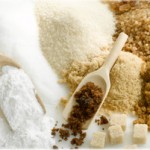Looking For Sweetness – All Sugar Is Not Created Equal
 Sugar is nearly unavoidable in our modern day diets. It’s everywhere and it’s highly addictive, which is why so many people eat far too much of it. Sugar is hidden in almost all things processed, including things you’re probably not aware of, such as salad dressings, sauces and popular condiments.
Sugar is nearly unavoidable in our modern day diets. It’s everywhere and it’s highly addictive, which is why so many people eat far too much of it. Sugar is hidden in almost all things processed, including things you’re probably not aware of, such as salad dressings, sauces and popular condiments.
Therefore, unless you’re eating a diet that consists entirely of whole foods (which is what I recommend, however challenging it might be!), you’re probably consuming sugar, even more than you think.
As we all know, sugar has a tremendous negative impact on our health, therefore it is very important to reduce the amount of sugar we consume. However, there are many different kinds of sweeteners, and it can be difficult to read an ingredient label and understand its impact on your body.
In this article, the different kinds of sweeteners and the various effects it has on your body, will be explained. Then you can make a decision on which sweeteners you can use, and which should rather be avoided.
Fructose vs. High Fructose Corn Syrup
Proponents of high fructose corn syrup have tried to argue that fructose and high fructose are metabolised in similar ways within the body, but the truth is that fructose and high fructose are different on a chemical level, and the body responds differently when they are consumed.
Fructose is a basic molecule of a simple sugar, with a unique chemical structure, found in most fruits and some vegetables. High fructose corn syrup has basic fructose in it, and it is comprised of about 50% glucose and 50% fructose. Both fructose and high fructose corn syrup cause spikes in your blood sugar levels, which means that they both need to be limited in your diet. However, if you have to choose between the two, fructose is a better option since it is most similar to its natural state.
Solid Sugar, Liquid Sugar, Treacle Sugar
Some people say that sugar is sugar, and it doesn’t matter how you eat it, because all types of sugar have the same impact on the body. Even though all types of sugar can have an impact on your blood sugar levels, research has uncovered information that shows that the different types of sugar can respond in various ways within the body.
Research shows that sugar in liquid products, such as cold drinks and juice, is worse than solid sugar, such as candy and cookies. People who drink sugar, often eat sugar as well, resulting in a much higher sugar consumption. Another problem is that liquid sugar is much easier to over consume than eating sugar.
Dark brown treacle sugar (closest to its sugar cane plant source) causes less of a sugar spike in your blood, than white, refined sugar or ordinary brown sugar. It still has to be limited though, but if you must have some sugar, rather use 1 or 2 teaspoons of treacle sugar per day.
Raw Honey vs. Fake Honey
There are many health benefits that can be gained by eating real, or raw, honey, as long as it is consumed in the raw form. The problem is that most ‘honey’ found at the grocery store is fake honey and highly processed. The final product is a combination of fructose and glucose. This fake honey has a similar metabolic impact on your body as high fructose corn syrup.
Research shows that raw honey is beneficial for cholesterol levels, immune system, nervous system and heart health.
Stevia, Xylitol and Agave
Stevia and Xylitol are both sweeteners that are used as a replacement for sugar because they are lower in calories and still provide the sweet taste that people want. Don’t be fooled into thinking that they are similar ingredients though, because Stevia and Xylitol come from different sources.
Stevia is a herb, 300 times sweeter than table sugar. Because it is a herb and not a type of refined sugar, it has zero calories and has been shown to improve insulin sensitivity. However, be aware of over processed Stevia, and try to take it as close to its plant source as possible.
Xylitol is a sugar that occurs naturally within certain vegetables and fruits, and it can be used as a substitute for table sugar. It has about the same sweetness as sugar, but approximately 30% of the calories, and consequently a lower impact on blood sugar levels (compared to table sugar). This sweetener is often used in chewing gum because it might help to reduce plaque buildup.
Agave is made from the same succulent plant that tequila is made of, tastes like sugar, also contains fructose, but doesn’t cause the extreme spikes in blood sugar that table sugar does. Again, be aware of over processed Agave, use it carefully and as close to its natural plant source as possible.
What should I choose?
If you are going to eat something sweet, the best approach is to avoid sweet tasting foods all together, in order to train your taste buds not to crave sweet foods. But if you had to choose a sweetener, go with Stevia, Xylitol or Agave, because it doesn’t have such a strong impact on your blood sugar levels and won’t impact your insulin as much.
Try eating foods in their most natural form. Avoid high fructose corn syrup. If you are going to eat honey, keep it raw and real. Always keep in mind that the less sugar you consume on a daily basis, the better.
This article has been adapted and edited by Dr Arien, from the original article written by Shin Otake.
Click here for more information on sugars and sweeteners.
